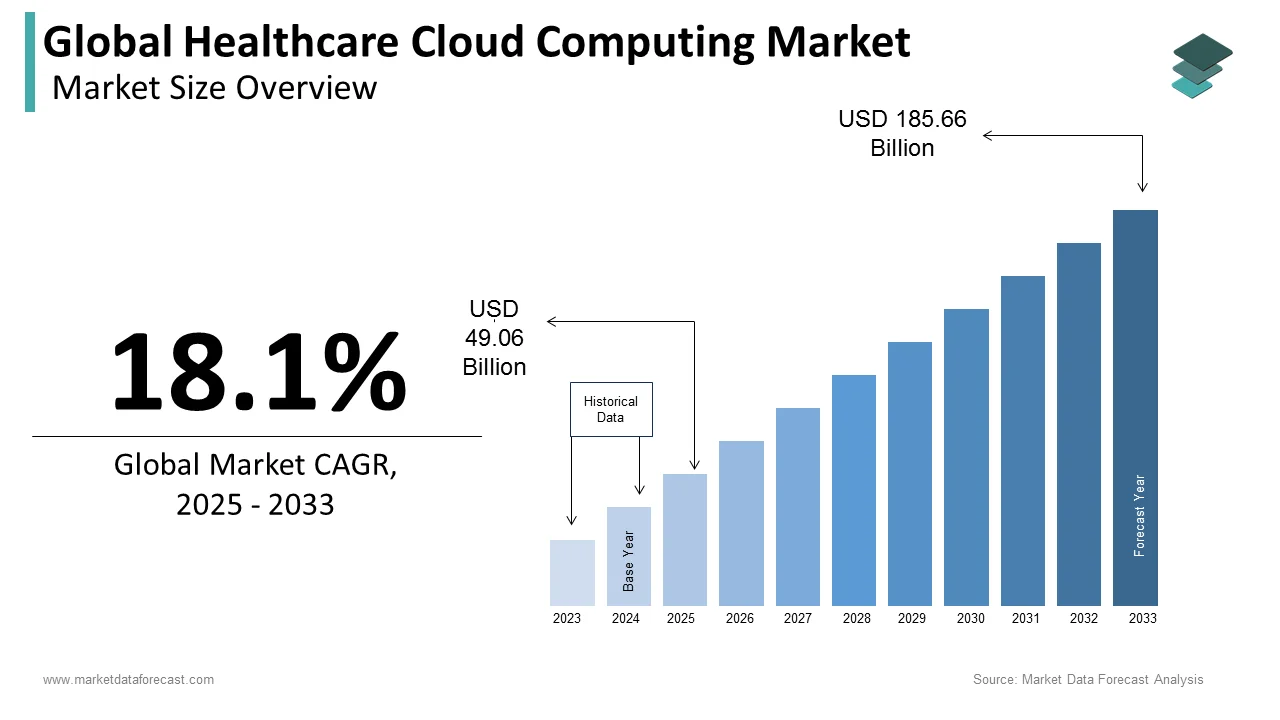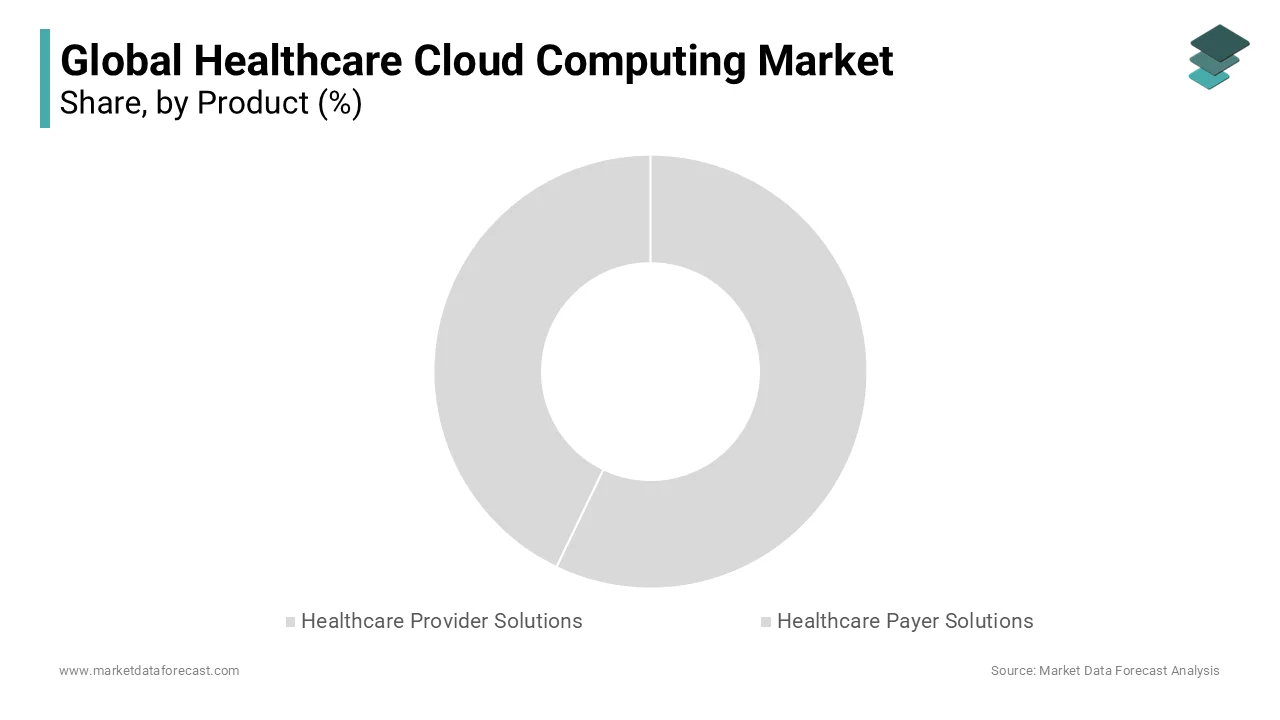Global Healthcare Cloud Computing Market Size, Share, Trends & Growth Forecast Report By Product (Provider Solutions & Payer Solutions), Deployment Model (Private Cloud, Public Cloud & Hybrid Cloud), Component Service Model, Pricing Model and Region (North America, Europe, Asia-Pacific, Latin America, Middle East and Africa), Industry Analysis From 2025 To 2033
Global Healthcare Cloud Computing Market Size
The size of the global healthcare cloud computing market was worth USD 41.54 billion in 2024. The global market is anticipated to grow at a CAGR of 18.1% from 2025 to 2033 and be worth USD 185.66 billion by 2033 from USD 49.06 billion in 2025.
The penetration of cloud computing in the healthcare industry has been growing over the last few years. As a result, the need for proper data storage, management, and flexible accessibility for the healthcare industry is increasing significantly. Cloud computing is an effective solution for these issues. Using cloud computing, the storage of continuously growing electronic health records, medical images, and other patient data is possible and can be accessed from anywhere using the Internet. The adoption of cloud computing is growing aggressively due to the associated advantages, such as scalability, cost-effectiveness, flexibility, and accessibility. Currently, cloud computing has made it possible for healthcare providers to access patient records, track their historical medication data, and even communicate with other healthcare providers in real time. In addition, using cloud computing, healthcare data can be perfectly secured and even generate backup to be safe from loss or damage.
MARKET DRIVERS
One of the major key driving factors boosting the growth of the healthcare cloud computing market is the increase in access to advanced technology and its adoption by healthcare authorities. Approximately 85% of healthcare organizations currently use cloud computing technology. This trend is being fueled by digitalization and an understanding of the opportunities presented by cloud computing technologies in the healthcare industry, including machine learning and AI tools for data management and privacy that enhance scalability, storage, and flexibility. The worldwide healthcare sector's increased adoption of telehealth and telemedicine platforms is driving the market's expansion. To improve operational effectiveness, data management, and patient care, healthcare organizations.
To improve operational efficiency, data management, and patient care, healthcare organizations are implementing digital technologies. The percentage of adults who used telemedicine increased with age from 30.2% among adults aged 18-29 to 47% among those aged between 35 and 60, the rising growth of the market is largely due to the increasing penetration of telehealth and telemedicine platforms across the global healthcare sector.
Another important factor driving the growth of the healthcare cloud computing market is the increasing desire for affordable healthcare solutions. The worldwide healthcare cloud computing market is anticipated to develop during the projected period due to the increasing demand and use of cloud techniques for cost-cutting in the healthcare sector. Medical organizations and doctors may significantly reduce costs by utilizing cloud techniques. Healthcare providers can access cutting-edge technology infrastructure and resources on a pay-as-you-go basis by utilizing cloud computing services. By doing away with the requirement for expensive hardware and software upgrades, the healthcare industry may now access cutting-edge IT resources without having to bear significant financial pressures. Cloud-based solutions require less initial capital expenditure because they are scalable, flexible, and simple to modify to meet changing demands. Around 15.4 billion people use cloud computing in the healthcare sector due to its affordability, and by 2033, that number is predicted to rise.
Telehealth and Telecloud consultation development favors the growth of the healthcare cloud computing market during the forecast period. A greater number of patients are being seen as a result of the increasing disease load and aging of the global population. An enormous amount of data is being produced by the growing patient population, which is placing pressure on the healthcare systems to provide efficient and prompt patient care. Therefore, healthcare organizations are implementing digital technologies to increase operational efficiency, handle data better, and improve patient care. The global market for healthcare cloud infrastructure is expanding significantly due to the increasing usage of digital technologies across the healthcare industry. According to a WHO poll, 60% of medical professionals concur that telemedicine has aided them in providing high-quality care. 93% of those who use telehealth engage in live, interactive video meetings with patients, compared to 69% who conduct audio-only visits.56 percent of those questioned feel motivated to use telehealth in their jobs more regularly. This statistic illustrates how technology use has increased during the forecast period, which forecasts growth in the market by 2033.
The adoption of wearable technology, the Internet of Things, and data analytics have increased the demand for cloud computing technology in the healthcare sector. Additionally, the widespread use of digital outputs, The trend of digitizing healthcare infrastructure and the significant uptake of electronic medical records have increased the market potential for cloud computing.
MARKET RESTRAINTS
Although many factors are propelling the growth of the healthcare cloud computing market, there are also some factors that could restrain that market's expansion throughout the forecast period. For example, although cloud computing technology is used for patient data management and storage, there is still a growing concern about data privacy, and there are more instances of cloud data breaches than there were in the past. The platform for cloud services lacks standardization, which restricts data sharing amongst cloud tools and causes portability problems. Due to the sensitivity of patient information and the need to maintain a high level of privacy, data breaches are becoming an increasingly serious problem. Patients' concerns about the security of their personal information have also increased the need to maintain data protection standards. Another impediment is the absence of standardization among cloud service providers, which prevents data from being shared between various cloud tools and causes portability problems.
REPORT COVERAGE
|
REPORT METRIC |
DETAILS |
|
Market Size Available |
2024 to 2033 |
|
Base Year |
2024 |
|
Forecast Period |
2025 to 2033 |
|
Segments Covered |
By Product, Deployment Model, Component Service Model, Pricing Model, and Region |
|
Various Analyses Covered |
Global, Regional & Country Level Analysis, Segment-Level Analysis, Drivers, Restraints, Opportunities, Challenges; PESTLE Analysis; Porter's Five Forces Analysis, Competitive Landscape; Analyst Overview of Investment Opportunities |
|
Regions Covered |
North America, Europe, Asia Pacific, Latin America, Middle East & Africa |
|
Market Leader Profiled |
IBM, CareCloud Corporation, Agfa-Gevaert N.V., Merge Healthcare Inc |
SEGMENTAL ANALYSIS
By Product Insights
The healthcare provider solutions segment is predicted to dominate the global healthcare cloud computing market during the forecast period with clinical information systems and non-clinical information systems due to demand for the increase of clinical and non-clinical information systems. In addition, the growth rate is attributed to a surge in demand for cloud-based CIS and NCIS solutions, which have advantages like smooth integration of applications, effective migration strategies, data control, compliance, security, and on-demand storage.
By Deployment Model Insights
The private cloud deployment model is the largest category and is anticipated to rule the market during the projected period. The Segment growth is mostly driven by the increased deployment of private cloud by healthcare authorities. Private clouds have additional advantages, including improved data security and control over the infrastructure, which are the main factors propelling the segment's growth over the projection period.
A hybrid cloud deployment approach is used by almost 50% of healthcare organizations, and this category is expected to grow at the highest CAGR during the projected period. Healthcare organizations that use hybrid clouds can benefit from public cloud features like scalability and cost-effectiveness and private cloud features like control over sensitive data, making the hybrid cloud segment an opportunistic one globally during the forecast period.
By Component Insights
The service segment, which is based on the component, is the one that is expected to dominate the market during the forecast period due to the rising need for various technical service providers to deploy digital computing systems throughout hospitals or other healthcare facilities. In 2024, the service segment's market share was approximately 82%. The healthcare organization has been encouraged to outsource the tasks associated with implementing cloud computing technology due to the ready availability of IT personnel. It is also anticipated that rising investments in hospital digitization will fuel industry expansion.
Due to hardware's critical role in the installation of cloud-based solutions, the hardware market is anticipated to be the most opportunistic during the projected period. The gear includes cutting-edge electronic equipment and machine-to-human interface technology. In the market for healthcare cloud computing, scalability, performance, data security, dependability, regulatory compliance, and cost efficiency are important hardware drivers.
By Pricing Model Insights
The pay-as-you-go segment had the largest market share in 2024, and it continues to dominate the market during the forecast period. The healthcare cloud computing market's pay-as-you-go sector is important because it has the potential to reduce costs, offer flexibility and scalability, democratize access to cutting-edge IT resources, foster innovation, make resource optimization easier, and reduce financial risks. This pricing structure makes using the cloud in the healthcare industry an appealing alternative because it is well-suited to the changing needs and budgetary realities of healthcare organizations.
Due to its relevance for cost reduction, flexibility, handling peak loads, research and testing, resource availability, and better resource utilization in the healthcare cloud computing industry, the spot pricing model is most opportunistic, increasing at the fastest CAGR during the forecast period. However, healthcare organizations must weigh the financial benefits against any possible risks and consider if spot instances are appropriate for specific workloads or applications.
By Service Model Insights
The SaaS segment captured the leading share of the global healthcare cloud computing market in 2024. Factors such as the growing adoption of cloud-based software applications and the advantages associated with the SaaS model, such as cost-effectiveness, easy-to-use automatic updates, and maintenance, propel the segment's growth. SaaS is mostly used in applications such as EHRs, practice management software, and patient engagement tools.
On the other hand, IaaS and PaaS segments are anticipated to hold a considerable share of the global market during the forecast period. This is because these segments provide flexibility and scalability to healthcare organizations managing the applications and infrastructure essential for a smooth flow of operations. Due to this, the segments are growing considerably and witness a healthy CAGR during the forecast period.
By End-use Insights
The healthcare provider segment is the largest growing segment during the forecast period. It has market share around 70% in 2024, this are the key end users in the market which is expected to account for projected CAGR of 22.5% from 2024-2033. Cost savings, scalability and flexibility, data accessibility, security and data protection, and the chance for innovation and technological advancements are driving factors for healthcare providers in the healthcare cloud computing market. These elements help healthcare providers employ cloud computing solutions more frequently to boost patient care, enhance healthcare delivery, and increase operational effectiveness.
The market is also favored by the payers in the healthcare industry, who are adopting cloud technologies for effective data handling, fraud detection, and risk assessment. Payers in the healthcare industry include healthcare insurance companies, sponsors, and third-party payers. Healthcare payers are primarily motivated by increased security and compliance, interoperability and integration, as well as opportunities for innovation and digital transformation. Cloud computing enables payers to innovate, enhance member services, and optimize operating procedures in the rapidly evolving healthcare industry.
REGIONAL ANALYSIS

Geographically, North America is anticipated to lead the market during the forecast period owing to the growing usage of telemedicine and remote patient monitoring across North American countries. This figure is projected to increase to 75.6 million by 2026. The growth rate of the North American market is being driven by an increase in data-driven healthcare initiatives and the use of digital healthcare technology.
The APAC is anticipated to experience the highest CAGR, which will be over 23.5%, during the forecast period. The market for healthcare infrastructure is expected to see tremendous growth thanks to the abundance of opportunities this region has generated for cloud-based businesses operating there. This expansion is fueled by elements including the expanding use of digital health solutions in Asia, the modernization of the Chinese healthcare system, and the rapidly expanding healthcare sector in India.
In 2024, Europe accounted for a sizeable portion of the worldwide market; throughout the projected period, it is anticipated to display a promising CAGR of 28.8%. One of the key factors boosting the development of the European healthcare cloud computing market is the quickening acceptance of healthcare technology in European nations. By 2033, the market is anticipated to be worth 31.2 billion. Investments in modernizing healthcare infrastructure are increasing, which helps the European industry expand.
Latin America is predicted to increase at a CAGR of 20.2% during the forecast period as a result of the rising adoption of cloud computing. Big data, the Internet of Things, improved profitability, mobility, and the use of managed cloud services are some of the key driving forces anticipated to dominate the market throughout the projection period.
The healthcare cloud computing market in the Middle East and Africa is anticipated to develop at a CAGR of 15% from 2025 to 2033, reaching a worth of over US$ 6.5 billion. The growing investments in healthcare IT, the desire for greater healthcare access, data security, and compliance, and the development of digital health initiatives are what are driving the Middle East and Africa's healthcare cloud computing industry.
KEY MARKET PARTICIPANTS
Companies such as IBM, CareCloud Corporation, Agfa-Gevaert N.V., Merge Healthcare Inc., Carestream Corporation, Cerner Corporation, Microsoft Corporation, Oracle Corporation, ClearData Networks Inc., Sectra AB, Nuance Communications, G.E. Healthcare, athenahealth Inc., NextGen Healthcare, Siemens Healthineers, and Dell Inc. are playing a dominating role in the global healthcare cloud computing market.
RECENT HAPPENINGS IN THIS MARKET
- In February 2022, IBM and SAP strengthened their relationship to enable clients to shift their workloads from SAP solutions to the cloud.
- In January 2022, Francisco Partners and IBM entered into a contract for the acquisition of healthcare data and analytics assets from IBM. These assets include health insight, market scans, clinical development, and social program management.
- In July 2021, Amazon announced the launch of its AWS for health cloud services for biopharma, healthcare, and genomics.
- In October 2020, Microsoft (US) and Allscripts (US) developed a five-year plan to revolutionize cloud-based IT solutions.
MARKET SEGMENTATION
This research report on the global healthcare cloud computing market has been segmented & sub-segmented based on the product, deployment, component service, pricing, and region.
By Product
-
Healthcare Provider Solutions
-
Clinical Information Systems (CIS)
- EHR/EMR
- PACS and VNA
- RIS
- LIS
- PIS
- PHM Solutions
- Telehealth Solutions
- Other CIS
- Non-clinical Information Systems (NCIS)
- RCM Solutions
- Financial Management Solutions
- HIE Solutions
- Supply Chain Management Solutions
- Billing & Accounts Management Solutions
- Other NCIS
-
- Healthcare Payer Solutions
- Claims Management Solutions
- Payment Management Solutions
- Customer Relationship Management Solutions
- Provider Network Management Solutions
- Fraud Management Solutions
By Deployment Model
- Private Cloud
- Hybrid Cloud
- Public Cloud
By Component
-
Hardware
-
Server
-
Storage
-
Network
-
-
Services
-
Software-as-a-service (SaaS)
- Infrastructure-as-a-service (IaaS)
- Platform-as-a-service (PaaS)
-
By Pricing Model
- Pay-as-you-go
- Spot Pricing
By Service Model
- Software-as-a-Service (SaaS)
- Infrastructure-as-a-Service (IaaS)
- Platform-as-a-Service (PaaS)Payers
By Based on End-use
- Healthcare Payers
- Healthcare providers
By Region
- North America
- Europe
- Asia-Pacific
- Latin America
- Middle East and Africa
Frequently Asked Questions
How much is the global healthcare cloud computing market going to be worth by 2033?
The global healthcare cloud computing market size is estimated to be worth USD 185.66 billion by 2033.
Which segment by product dominated the healthcare cloud computing market in 2024?
The healthcare provider solutions segment by product led the healthcare cloud computing market in 2024.
Which are the significant players operating in the healthcare cloud computing market?
Companies such as IBM, CareCloud Corporation, Agfa-Gevaert N.V., Merge Healthcare Inc., Carestream Corporation, Cerner Corporation, Microsoft Corporation, Oracle Corporation, ClearData Networks Inc., Sectra AB, Nuance Communications, GE Healthcare, athenahealth Inc., NextGen Healthcare, Siemens Healthineers, and Dell Inc. are playing a key role in the healthcare cloud computing market.
Related Reports
Access the study in MULTIPLE FORMATS
Purchase options starting from $ 2500
Didn’t find what you’re looking for?
TALK TO OUR ANALYST TEAM
Need something within your budget?
NO WORRIES! WE GOT YOU COVERED!
Call us on: +1 888 702 9696 (U.S Toll Free)
Write to us: [email protected]


